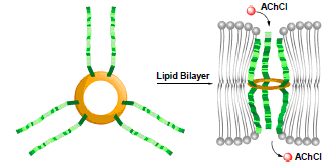

乙酰胆碱经人工通道的跨膜输送
收稿日期: 2015-05-03
修回日期: 2015-05-13
网络出版日期: 2015-05-15
基金资助
国家自然科学基金(No. 21422202)资助项目.
Transmembrane Transport of Actylcholine through Artificial Channels
Received date: 2015-05-03
Revised date: 2015-05-13
Online published: 2015-05-15
Supported by
Project supported by the National Natural Science Foundation of China (No. 21422202).
祝平平 , 辛鹏洋 , 侯军利 , 黎占亭 . 乙酰胆碱经人工通道的跨膜输送[J]. 有机化学, 2015 , 35(9) : 1994 -1998 . DOI: 10.6023/cjoc201505003
In natural system, the transmembrane transport of actylcholine is one of the important processes for realizing the neural signal transduction, which relies on some specific proteins. The development of artificial systems displaying the similar transport capability is not only fundamentally important but also may find potential biological and medical applications. However, this has been a challenge because of lacking architectures with proper cavity size for passing of actylcholine. In this paper, the artificial channels have been built from the Phe tripeptide attached to aromatic hydrazide macrocycles. Dynamic fluorescent experiments on lipid vesicles and patch clamp experiments on planar lipid bilayer revealed that the channels can transport actylcholine. The transport selectivity was found to increase with the increasing cavity size of the macrocycles.

[1] Yang, F.-Y. Biomembranes, Science Press, Beijing, 2005 (in Chinese). (杨福愉, 生物膜, 科学出版社, 北京, 2005.)
[2] Hille, B. Ionic Channels of Excitable Membranes, 3rd ed, Sinauer Associates, Sunderland, MA, 2001.
[3] Ashcroft, F. M. Ion Channels and Disease, Academic Press, San Diego and London, 2000.
[4] (a) Sakai, N.; Mareda, J.; Matile, S. Acc. Chem. Res. 2005, 38, 79. (b) Li, X.; Wu, Y.-D.; Yang, D. Acc. Chem. Res. 2008, 41, 1428. (c) Legrand, Y.-M.; Barboiu, M. Chem. Rec. 2013, 13, 524. (d) Matle, S.; Fyles, T. M. Acc. Chem. Res. 2013, 46, 2741. (e) Gong, B.; Shao, Z. Acc. Chem. Res. 2013, 46, 2856. (f) Montenegro, J.; Ghadiri, M. R.; Granja, J. R. Acc. Chem. Res. 2013, 46, 2955. (g) Gokel, G. W.; Murillo, O. Acc. Chem. Res. 1996, 29, 425. (h) Mayer, M.; Yang, J. Acc. Chem. Res. 2013, 46, 2998. (i) Xin, P.; Zhu, P.; Su, P.; Hou, J.-L.; Li, Z.-T. J. Am. Chem. Soc. 2014, 136, 13078.
[5] (a) Cho, H.; Widanapathirana, L.; Zhao, Y. J. Am. Chem. Soc. 2011, 133, 141. (b) Hu, X.-B.; Chen, Z.; Tang, G.; Hou, J.-L.; Li, Z.-T. J. Am. Chem. Soc. 2012, 134, 8384. (c) Chen, L.; Si, W.; Zhang, L.; Tang, G.; Li, Z.-T.; Hou, J.-L. J. Am. Chem. Soc. 2013, 135, 2152.
[6] (a) Parsons, S. M.; Prior, C.; Marshall, I. G. Int. Rev. Neurobiol. 1993, 35, 279. (b) Usdin, T. B.; Eiden, L. E.; Bonner, T. I.; Erickson, J. D. Trends Neurosci. 1995, 18, 218.
[7] Xin, P.; Zhang, L.; Su, P.; Hou, J.-L.; Li, Z.-T. Chem. Commun. 2015, 51, 4819.
[8] Busschaert, N.; Wenzel, M.; Light, M. E.; Iglesias-Hernandez, P.; Perez-Tomas, R.; Gale, P. A. J. Am. Chem. Soc. 2011, 133, 14136.
[9] Matile, S.; Jentzsch, A. V.; Montenegro, J.; Fin, A. Chem. Soc. Rev. 2011, 40, 2453.
[10] Chui, J. K. W.; Fyles, T. M. Chem. Soc. Rev. 2012, 41, 148.
[11] Fyles, T. M.; Loock, D.; van Straaten-Nijenhuis, W. F.; Zhou, X. J. Org. Chem. 1996, 61, 8866.
[12] Jeon, Y. J.; Kim, H.; Jon, S.; Selvapalam, N.; Oh, D. Y.; Seo, I.; Park, C. S.; Jung, S. R.; Koh, D. S.; Kim, K. J. Am. Chem. Soc. 2004, 126, 15944.
[13] Ashley, R. H. In Ion Channels: a Practical Approach, Ed.: Ashley, R. H., Oxford University Press, Oxford, UK, 1995.
/
| 〈 |
|
〉 |